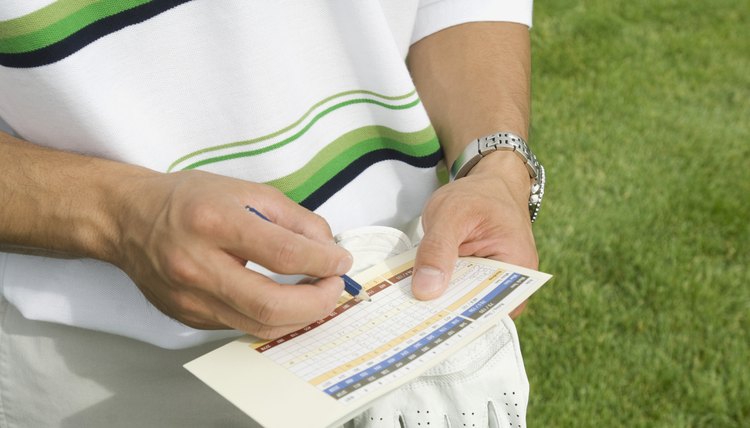What is a Good Golf Score?

In golf, the term par is used to describe the expected number of shots that it takes to play each hole. The formula to ascertain par for a certain hole is to add the number of shots it should take to reach the green from the tee and then add two putts. Holes are either par threes, fours or fives and the total par of all the holes comprises the par for the entire course. Golf courses normally have a par that ranges between 70 and 72; any score that is at par or under par is considered good.
Overview
In golf, the term par is used to describe the expected number of shots that it takes to play each hole. The formula to ascertain par for a certain hole is to add the number of shots it should take to reach the green from the tee and then add two putts. Holes are either par threes, fours or fives and the total par of all the holes comprises the par for the entire course. Golf courses normally have a par that ranges between 70 and 72; any score that is at par or under par is considered good.
Amateurs
The amateur golfer who is not that skilled at golf dreams of shooting par but such aspirations are beyond his ability. Scores that translate into one over par per each hole are more realistic as a goal, meaning that on a par 72, 18-hole course, a score that is less than 90 would be considered a good one.
There are many amateurs that are quite accomplished; for them a score around par or slightly below is not unrealistic. The champions of the multitude of clubs around the United States will shoot under par to win their tournaments, but the courses are much less demanding in the vast majority of cases than those that the professional golfers play on.
Professionals
The winning score of a Professional Golfer's Association event will invariably be under par.
The pros play four rounds and sometimes even five over courses that are much longer in terms of yardage than what amateurs play on.
These courses have deep rough that make an errant drive costly and rolling greens that can be lightning fast to putt on. However, the skill set of a professional golfer is such that they can handle such conditions.
Players in these tournaments will frequently shoot in the mid-60s, with the record for the lowest-ever single round being the 59 shared by Al Geiberger in 1977, Chip Beck in 1991 and David Duval in 1999. The best score for a four-round tournament, which equates to 72 total holes played, is the 254 by Tommy Armour III at the 2003 Texas Open.
Majors
The four major golf events that professionals aspire to win are the Masters, the U.S. Open, the British Open and the PGA Championship. A good score at these events is much different from a normal PGA tournament as the conditions are usually much tougher and the courses designed to present a challenge even to the best golfers in the world. The Masters is played in Augusta, Georgia, every April, and depending on the weather conditions a good score can be simply one or two shots under par.
The U.S. Open in June often sees the winner shoot par or even slightly over as the conditions are made much more drastic for the tournament, especially the length of the rough around the fairways and greens, which makes players pay dearly when a bad shot is struck. The British Open is played on different courses each year in the United Kingdom in July and often the wind is severe and the weather rainy and damp; a good score there would be a 70 or a 71 under such conditions. Of the four major tournaments the lowest score each year is normally posted in the PGA Championship each August, although the event can be held at courses that yield few good scores on a consistent basis.
Writer Bio
John Lindell has written articles for "The Greyhound Review" and various other online publications. A Connecticut native, his work specializes in sports, fishing and nature. Lindell worked in greyhound racing for 25 years.
